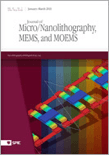
Journal of Micro-Nanopatterning Materials and Metrology-JM3
Scope & Guideline
Shaping Tomorrow's Technologies with Cutting-Edge Research
Introduction
Aims and Scopes
- Lithography Techniques:
The journal emphasizes various lithography methods including photolithography, electron beam lithography, and nanoimprint lithography. Research in this area focuses on improving resolution, throughput, and defect reduction. - Metrology Innovations:
A core focus is on developing and refining metrology techniques for measuring critical dimensions, overlay accuracy, and defect detection in semiconductor manufacturing. This includes advanced imaging and measurement techniques. - Material Development:
The journal covers studies on new materials for lithography, including photoresists and mask materials, with an emphasis on chemical formulations and their performance in extreme ultraviolet (EUV) lithography. - Computational Approaches and Machine Learning:
There is a growing body of work on computational modeling and machine learning applications aimed at optimizing lithographic processes and improving defect detection and characterization. - Advanced Packaging Technologies:
Research related to advanced packaging solutions, such as panel-level packaging and integration of micro and nano devices, is increasingly featured, reflecting industry trends towards miniaturization and enhanced performance.
Trending and Emerging
- Curvilinear Mask Technologies:
Research into curvilinear mask design and metrology is on the rise, addressing the challenges posed by complex geometries in modern semiconductor devices and enhancing performance in advanced lithography. - Machine Learning Applications:
There is a notable increase in the application of machine learning techniques for optimizing lithography processes, defect detection, and metrology, demonstrating the potential of AI in semiconductor manufacturing. - EUV Lithography Advances:
With the ongoing deployment of EUV lithography in production, research focused on improving EUV materials, processes, and metrology techniques is trending, highlighting its critical role in future semiconductor manufacturing. - Panel-Level Packaging Innovations:
As the demand for advanced packaging solutions increases, research on panel-level packaging and integration technologies is emerging, reflecting industry trends towards miniaturization and performance enhancement. - 3D and Multi-dimensional Metrology:
Emerging themes in three-dimensional metrology techniques are gaining attention, with a focus on improving accuracy and precision in measuring complex structures in semiconductor devices.
Declining or Waning
- Traditional Optical Lithography:
As the industry moves towards extreme ultraviolet (EUV) and other advanced lithography techniques, traditional optical lithography methods appear less frequently in newer publications. - Single Patterning Techniques:
Research on single patterning techniques is becoming less common, as the industry increasingly adopts multi-patterning approaches to meet the demands of smaller feature sizes. - Basic Resist Chemistry:
While foundational studies in resist chemistry were prominent in earlier years, recent publications suggest a shift towards more application-focused research, potentially reducing the emphasis on fundamental resist chemistry. - General Reviews on Historical Techniques:
There seems to be a waning interest in broad reviews of older lithographic techniques, as the focus shifts to novel and emerging technologies that are more relevant to current industry challenges.
Similar Journals
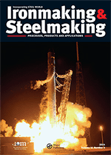
IRONMAKING & STEELMAKING
Pioneering Research in Metallurgical EngineeringIRONMAKING & STEELMAKING is a premier peer-reviewed journal published by SAGE Publications Inc, dedicated to advancing the field of metallurgical engineering and materials science. With a notable ISSN of 0301-9233 and an E-ISSN of 1743-2812, this journal has established itself as a significant platform for disseminating high-quality research on ironmaking processes, steel production, and associated technologies. Covering a broad scope of topics, it is indexed in the top quartiles (Q2) in Materials Chemistry, Mechanical Engineering, Mechanics of Materials, and Metals and Alloys for 2023, underscoring its pivotal role in these disciplines. Since its inception in 1974 and continuing through 2024, IRONMAKING & STEELMAKING attracts a global audience of researchers, professionals, and students, contributing valuable insights and innovations in the field. Although not an open-access publication, subscribers can access essential findings that shape the future of metallurgy and steelmaking. This journal not only serves as a repository of knowledge but also as a beacon for ongoing research and technological advancement, making it a must-read for those passionate about materials science.

Optica
Unleashing potential through open-access research.Optica is a premier open-access journal published by the Optica Publishing Group, designed to disseminate high-quality research across the fields of Atomic and Molecular Physics and Optics. Since its inception in 2014, it has established itself as a vital resource for the scientific community, as evidenced by its impressive Q1 rankings in both relevant categories in 2023 and its notable positions in the Scopus rankings—#9 in Atomic and Molecular Physics and #13 in Materials Science. Featuring cutting-edge research from leading experts, Optica aims to foster innovation and collaboration by providing unrestricted access to groundbreaking discoveries and advancements. Researchers, professionals, and students alike will find invaluable insights and trends that drive the ever-evolving scope of optical science and materials technology. With its commitment to open access, Optica ensures that knowledge is accessible, empowering the global community of scientists and researchers to embark on new explorations.
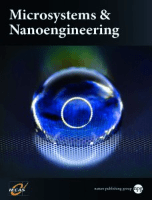
Microsystems & Nanoengineering
Pioneering Research for a Smaller, Smarter FutureMicrosystems & Nanoengineering, published by SpringerNature, stands at the forefront of advancing knowledge in the fields of atomic and molecular physics, condensed matter physics, electrical and electronic engineering, and materials science. With an impressive impact factor and categorized in Q1 across multiple prestigious fields in 2023, this journal not only provides a platform for high-quality research but also reflects the vitality of innovations within these disciplines. Since its transition to Open Access in 2015, it has significantly broadened accessibility for researchers, professionals, and students globally, facilitating the dissemination of groundbreaking findings. Addressed in the United Kingdom, with a focus on interdisciplinary collaboration, Microsystems & Nanoengineering aims to foster connections between theoretical advancements and practical applications, serving as a crucial resource for those engaged in cutting-edge nanoscale technologies and microsystems development. Immerse yourself in the latest studies and engage with the vibrant community that shapes the future of science and engineering.

Micro and Nano Systems Letters
Bridging Science and Engineering in Micro and Nano SystemsMicro and Nano Systems Letters, published by SPRINGERNATURE, is a prominent peer-reviewed journal dedicated to advancing the field of micro and nanosystems, with a special focus on biomaterials and biomedical engineering. Since its inception in 2013, this Open Access journal has provided a vital platform for researchers and practitioners to disseminate innovative findings and share insights that contribute to the growing body of knowledge in these rapidly evolving disciplines. With a remarkable impact reflected in its Q1 quartile rankings in both biomaterials and biomedical engineering, and impressive Scopus ranks placing it within the top tier of its fields, Micro and Nano Systems Letters plays a critical role in fostering collaboration and knowledge exchange among scientists and engineers worldwide. The journal is accessible globally, ensuring that research is widely disseminated and impacting a diverse audience to drive progress in technology and healthcare solutions.

Integrating Materials and Manufacturing Innovation
Bridging Innovation in Materials and Manufacturing.Integrating Materials and Manufacturing Innovation, published by SPRINGER HEIDELBERG, is a leading journal in the fields of Industrial and Manufacturing Engineering and Materials Science. Since its inception in 2012, this journal has established itself as a pivotal platform for disseminating cutting-edge research that bridges the gap between materials science and advanced manufacturing practices. With an impressive impact factor and consistent ranking within the Q1 and Q2 quartiles, it serves as an essential resource for academics and professionals alike, fostering innovation and collaboration in the industry. The journal aims to publish high-quality original research, reviews, and case studies that address contemporary challenges and advancements in materials and manufacturing integration. Researchers, students, and industry experts seeking to stay at the forefront of their fields will find this journal an invaluable addition to their academic and professional libraries.

PRINT QUARTERLY
Illuminating Contemporary Issues in Artistic ExpressionPRINT QUARTERLY is a prestigious journal dedicated to the exploration of visual arts and performing arts, published by PRINT QUARTERLY PUBLICATIONS in the United Kingdom. With an ISSN of 0265-8305, this journal has been a pivotal resource since its inception, particularly notable for its diverse range of scholarly articles aimed at both practitioners and academics. Although it does not currently provide open access, PRINT QUARTERLY is indexed in Scopus, ranking #392 out of 584 with a Q3 quartile classification in the 2023 category for Visual Arts and Performing Arts, reflecting its credible contribution to the field. The journal serves as a vital platform for researchers, professionals, and students to engage with contemporary issues, foster academic discourse, and expand understanding of visual and performing arts. As it continues to influence these dynamic disciplines, PRINT QUARTERLY remains an essential resource for those dedicated to the study and practice of the arts.
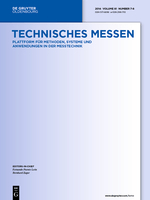
tm-Technisches Messen
Connecting Researchers to Transformative Measurement Solutionstm-Technisches Messen is a reputable academic journal published by WALTER DE GRUYTER GMBH, focusing on the field of engineering, specifically in Electrical and Electronic Engineering and Instrumentation. With a rich history dating back to 1931, this journal serves as a critical platform for disseminating research, innovations, and developments relevant to measurement and instrumentation technologies. Despite its current quartile rankings of Q3 in Electrical and Electronic Engineering and Q4 in Instrumentation for 2023, the journal continues to attract submissions from leading researchers, offering insights that drive advancements within these fields. Researchers and practitioners can access a wealth of knowledge through this publication, fostering collaboration and sparking new ideas. Located in Berlin, Germany, the journal operates without an open-access model, making it essential for universities and institutions to play an integral role in supporting their library access to this valuable resource. As the journal continues to evolve through 2024 and beyond, it remains a significant contributor to the global discourse in measurement technologies, making it a must-read for anyone involved in these dynamic areas of study.
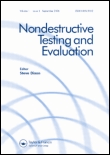
Nondestructive Testing and Evaluation
Exploring the Future of Nondestructive Testing MethodologiesNondestructive Testing and Evaluation, published by Taylor & Francis Ltd, is a premier international journal dedicated to the dissemination of innovative research and practices in the field of nondestructive testing and evaluation. With a robust ISSN of 1058-9759 and an E-ISSN of 1477-2671, this journal has consistently served as a vital resource for researchers, professionals, and students interested in enhancing the safety and reliability of materials and structures through advanced testing techniques. The journal's significant impact, evidenced by its Q2 rankings across multiple categories—including Materials Science, Mechanical Engineering, and Physics and Astronomy, along with commendable Scopus rankings—reflects its commitment to high-quality scholarship. Covering the convergence of research from 1989 to 2024, Nondestructive Testing and Evaluation plays a crucial role in advancing methodologies that drive innovation in various engineering disciplines. While currently not offering an Open Access option, the journal remains a respected platform for exchanging knowledge that shapes the future of nondestructive methodologies.
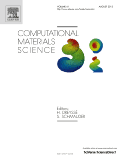
COMPUTATIONAL MATERIALS SCIENCE
Innovating Tomorrow’s Materials Through Computational ExcellenceCOMPUTATIONAL MATERIALS SCIENCE is a prestigious academic journal dedicated to the dissemination of innovative research in the field of computational materials science, emphasizing the interplay between computational methodologies and materials engineering. Published by ELSEVIER in the Netherlands, this journal showcases high-impact articles that contribute significantly to the understanding of material properties through computational techniques. As evidenced by its 2023 Scopus Rankings, which place it in the top quartiles across multiple disciplines including Computer Science, Materials Science, and Physics and Astronomy, it is a vital resource for researchers, professionals, and students alike. With a focus on advancing scientific knowledge and practical applications, COMPUTATIONAL MATERIALS SCIENCE aims to bridge the gap between theoretical investigations and experimental validation. Explore a wealth of cutting-edge research designed to inspire the next generation of innovations in materials science through this esteemed publication.

RUSSIAN JOURNAL OF NONDESTRUCTIVE TESTING
Transforming Knowledge into Practical Solutions in Nondestructive TestingRUSSIAN JOURNAL OF NONDESTRUCTIVE TESTING, published by PLEIADES PUBLISHING INC, is a respected academic journal that has been contributing significantly to the fields of Condensed Matter Physics, Materials Science, Mechanical Engineering, and Mechanics of Materials since its inception in 1996. With a concentrated focus on the latest advancements in nondestructive testing techniques, it serves as a vital resource for researchers, engineers, and practitioners seeking to improve material integrity and safety across various applications. Despite its classification in the Q3 quartile categories, the journal continues to foster scholarly dialogue and innovation in non-destructive research methodologies. Although it does not currently offer open access, the journal remains committed to disseminating high-quality research that influences both theoretical and practical landscapes. With an emphasis on quality, the journal seeks to connect academics and industry experts alike, thus enhancing the relevance and application of nondestructive testing in real-world contexts.